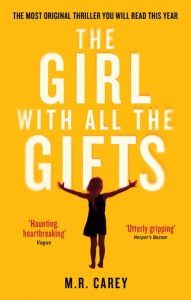The Girl with All the Gifts by M. R. Carey
 This book’s blurb is as ominous as it is deliberately vague, and I’m not one for hedging and hinting. If you haven’t read this book yet and don’t want to know any more details about its premise, then read no further. You have been warned.
This book’s blurb is as ominous as it is deliberately vague, and I’m not one for hedging and hinting. If you haven’t read this book yet and don’t want to know any more details about its premise, then read no further. You have been warned.
We’re in southern England. It’s twenty years on from the cataclysmic outbreak that devastated the world and turned all those it infected into mindless, unstoppable killing machines known as ‘hungries’. In one of the country’s last remaining military outposts a group of children are kept under armed guard; children who only need to eat once a week, are kept underground in steel cells, and who people are only able to approach after coating themselves in scent-blocking chemicals. The children have never thought to question why this might be. Every now and again a child will be wheeled away to the research laboratory, never to return. It’s only when the outpost is overrun that those inside realise the true dangers of the world they live in, and that not all the hungries are the monsters they’re presumed to be.
The Girl with All the Gifts is a wonderfully character-centred tale, set in a post-apocalyptic future and focusing on a rag-tag group of survivors with bucketloads of heart, conflict and chemistry. The main focus of the story is Melanie, a ‘hungry’ who retains her own personality and has a genius-level IQ, yet becomes a slavering monster at the barest scent of human flesh. The relationship between the girl Melanie and her former teacher Miss Justineau is the driving force behind much of the novel, and it’s a lovely thing to behold. In a novel filled with violence and despair – a novel that could just as easily have been written as an outright horror story – its focus on human relationships, particularly those based around children, makes it really compelling. It also creates a strong foundation of sympathy for the characters of Melanie and Miss Justineau, particularly when it becomes clear the astonishing lengths to which they will go to protect one another, and how determined they are to stay together against all odds. Almost as heartwarming is seeing how the other characters gradually come to change their outlook, all of which is based around little Melanie. That said, I would have liked a little more insight into the characters of Parks and Gallagher; their military background added a different perspective on the survivalist situation, but they remained very much supporting characters throughout.
Another aspect of The Girl with All the Gifts that makes it so absorbing is the fact that it’s written in the present tense. This creates a real sense of urgency and immediacy that keeps the reader constantly on their toes. It makes for a lot of tense moments, one or two in particular involving hungry-infested streets that had me literally holding my breath. Yet another thing I really liked, and that brought the story to life all the more, was how much time the author spent detailing the ‘how and why’ of the infection, most notably through the character of the psychopathic yet brilliant Dr Caldwell. Not only was all the conjecture fascinating, it also sounds totally believable: the cause of the infection has its roots in an existing natural phenomenon (I Googled it!) which sounds both plausible and terrifying.
Although I really enjoyed reading it, The Girl with All the Gifts was not what I expected, possibly because I had mixed signals about what to expect in the first place. I’ve heard it frequently described as a horror novel, yet the cover describes it as a thriller. I have to admit I was a little bit disappointed because, to me, it wasn’t quite either of these. Not that it isn’t thrilling (it is, frequently), and not that it isn’t frightening (it is, often), but there isn’t quite enough of either to give it that smack-in-the-gob impact I was expecting. In actuality it’s more of a post-apocalyptic road novel, philosophic and dystopian yet suffused with elements of horror. Which is absolutely fine (it’s actually incredibly effective) . . . it just doesn’t quite reflect the way it’s marketed.
This aside, I’d highly recommend The Girl with All the Gifts and really look forward to reading the sequel.
